#hagenbund
Explore tagged Tumblr posts
Photo
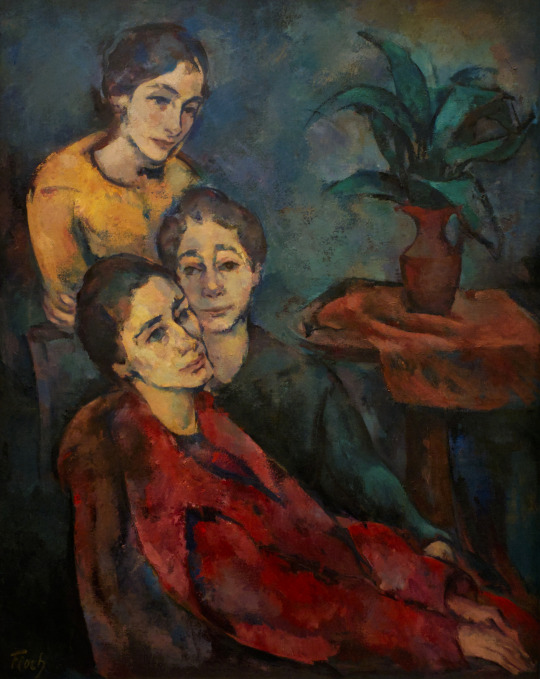
Josef FLOCH (1894-1977) “Frau Weiss und ihre Töchter Liese und Lene” (um 1923) “Frau Weiss and her daughters Liese und Lene” (c. 1923) Öl auf Leinwand / Oil on canvas BELVEDERE Wien / Vienna Ausstellung / Exhibition HAGENBUND - Von der gemäßigten zur radikalen Moderne HAGENBUND - From moderate to radical Modernism LEOPOLD MUSEUM Wien / Vienna - 2022/23
#josef floch#hagenbund#leopold museum vienna#vienna 1900#wien 1900#floch#academy of fine arts vienna#expressionism#Expressionismus#belvedere vienna#der hagenbund
26 notes
·
View notes
Text
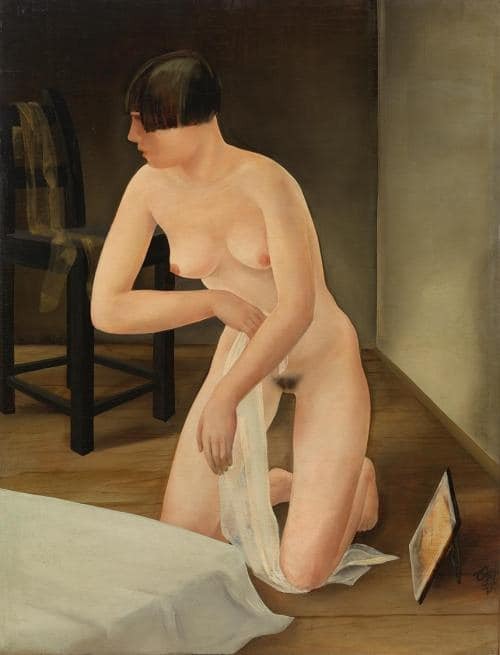
Otto Rudolf Schatz (1900 Wien – 1961 Wien), Kneeling, 1930, Oil on wood, 120 × 92 cm. Via Wien Museum.
Otto Rudolf Schatz was born on January 18, 1900, the son of a post office family in Vienna. From 1915 to 1918 Schatz studied at the Viennese Art Academy under Oskar Strnad and Anton von Kenner. In 1918 his studies were interrupted by military service in the First World War although he graduated in 1919. In 1923 Schatz became friends with the Viennese gallery owner Otto Kallir who became one of his most important patrons. Kallir continuously presented Schatz’s works in the Neue Galerie. In 1927 Schatz contributed woodcuts to the volume The New Town by the Berlin Büchergilde Gutenberg. From 1928 to 1938 he was a valued member in the Hagenbund in Vienna. When the National Socialists gained power in 1938 Schatz was forbidden to work. In 1938 he lived with his Jewish wife Valerie Wittal in Brno and in 1944 in Prague where he painted landscape miniatures. In 1944 Schatz was imprisoned in the Klettendorf labor camp and then transferred to the Graditz and Bistritz concentration camps.
44 notes
·
View notes
Text

Karel Špillar
Plakat der Mánes-Ausstellung im Hagenbund, Wien
1902
16 notes
·
View notes
Text
Old Vienna
Anno 1902
Zedlitzhalle , Zedlitzgasse Nr . 6

Der Hagenbund

Der „Hagenbund“ war eine im Jahre 1900 gegründete Künstlervereinigung in Wien. Der Namensursprung geht auf Josef Haagen zurück, Inhaber des Gasthauses „Zum Blauen Freihaus“ in der Gumpendorfer Straße. Dort trafen sich ab den 1870ern junge Maler, Bildhauer und Architekten zum Erfahrungsaustausch.
Etliche dieser Generation fanden sich anfänglich in der „Künstlerhaus Vereinigung“ und später im Verein „Wiener Sezession“ ein. Die oftmals innovationsfeindliche Gesinnung der und Ablehnung frischer Ideen der „Künstlerhaus Vereinigung“ führte zu einem Überlaufen vieler Mitglieder hin zum „Hagenbund“. Spätestens ab den 1910er-Jahren hatte dieser Verein den Status einer progressiven, zeitgenössischen Plattform für junge Talente.

Als Ausstellungsraum diente ab 1902 ein 400 m² umfassender Teil der adaptierten Zedlitzhalle Nahe des Stadtparks – siehe Beitrag von heute Vormittag bzw. dem Link dazu in den Kommentaren.
Der Verein wurde 1938 aufgrund der zu liberalen künstlerischen Ansichten und Meinungen, die im markanten Gegensatz zu den faschistischen Entwicklungen in Europa standen sowie der Emigration zahlreicher Mitglieder aufgelöst. Die Neugründung 1947 konnte nicht mehr an frühere Erfolge anknüpfen. 1965 wurde die im Zweiten Weltkrieg beschädigte Zedlitzthalle abgerissen und der Verein verschwand fast vollständig aus der Öffentlichkeit.

Zedlitzgasse - Blick von der Stubenbastei gegen die Riemergasse 1906

1 note
·
View note
Photo

Erwin Lang - Portrait of the dancer, actor and choreographer Grete Wiesenthal, woodcut
58 notes
·
View notes
Text
1 note
·
View note
Photo


Interior design drawings by Rudolf Tropsch, from Das Interieur, 1901.
Rudolf Tropsch was an Austrian architect, born in Budapest in 1870. Although hardly any buildings were built to his design, he was a member of the Hagenbund and contributed with his extraordinary and exquisite drawings for designs and projects to well-known magazines such as Der Architekt and often (as here) Das Interieur. This elusive artist was last seen in Bratislava in 1923, where, according to German Wikipedia, “his trace is lost”.
Source: +
48 notes
·
View notes
Photo

Ecstasy
Leopold Gottlieb
crédit: Art UK
#leopold gottlieb#leopolda gottlieba#ecstasy#kraków#hagenbund#expression#reddish browns and greens#colours#art#painting
3 notes
·
View notes
Text

Art mi alma Sigmund Walter Hampel (1868-1949) Austrian "A Deity" Son of a glass painter, in his father's workshop Hampel learned about design, material and technique. Studying the old masters at the Vienna Academy of Art, the artist quickly acquired a delicate colouring and improved his technical skills. From 1900 to 1911, he was a member of the Hagenbund, an artists’ association in Vienna.
9 notes
·
View notes
Photo
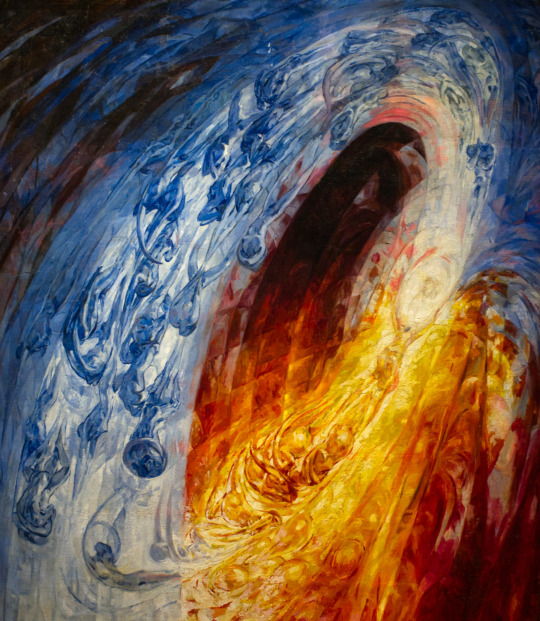
Georg JUNG (1899-1957) “Der Irrtum” - “The Fallacy” (1920/21)
Öl auf Leinwand / Oil on canvas Privatsammlung Salzburg / Private collection, Salzburg Ausstellung / Exhibition HAGENBUND - Von der gemäßigten zur radikalen Moderne HAGENBUND - From moderate to radical Modernism LEOPOLD MUSEUM Wien / Vienna - 2022/23
#georg jung#hagenbund#leopold museum vienna#vienna 1900#wien 1900#jung#der irrtum#the fallacy#expressionism#Expressionismus#cubism#kubismus#new objectivity#neue sachlichkeit#abstract painting
32 notes
·
View notes
Photo

Teodor Axentowicz (May 13, 1859 – Aug 26, 1938) was a Polish-Armenian painter and university professor. A renowned artist of his times, he was also the rector of the Academy of Fine Arts in Kraków. As an artist, Axentowicz was famous for his portraits and subtle scenes of Hutsul life, set in the Carpathians.
var quads_screen_width = document.body.clientWidth; if ( quads_screen_width >= 1140 ) { /* desktop monitors */ document.write('<ins class="adsbygoogle" style="display:inline-block;width:300px;height:250px;" data-ad-client="pub-9117077712236756" data-ad-slot="1897774225" >'); (adsbygoogle = window.adsbygoogle || []).push({}); }if ( quads_screen_width >= 1024 && quads_screen_width < 1140 ) { /* tablet landscape */ document.write('<ins class="adsbygoogle" style="display:inline-block;width:300px;height:250px;" data-ad-client="pub-9117077712236756" data-ad-slot="1897774225" >'); (adsbygoogle = window.adsbygoogle || []).push({}); }if ( quads_screen_width >= 768 && quads_screen_width < 1024 ) { /* tablet portrait */ document.write('<ins class="adsbygoogle" style="display:inline-block;width:300px;height:250px;" data-ad-client="pub-9117077712236756" data-ad-slot="1897774225" >'); (adsbygoogle = window.adsbygoogle || []).push({}); }if ( quads_screen_width < 768 ) { /* phone */ document.write('<ins class="adsbygoogle" style="display:inline-block;width:300px;height:250px;" data-ad-client="pub-9117077712236756" data-ad-slot="1897774225" >'); (adsbygoogle = window.adsbygoogle || []).push({}); }
Axentowicz was born May 13, 1859 in Braşov, Hungary (now Romania), to a family of Polish-Armenian ancestry. In 1893 in Chelsea, London, he married Iza Henrietta Gielgud, aunt of Val Gielgud and John Gielgud of the theatrical dynasty. A son, Philip S.A.D. Axentowicz was born in Chelsea in 1893.
Between 1879 and 1882 he studied at the Academy of Fine Arts in Munich. From there he moved to Paris, where he was a student of Carolus-Duran and continued his education until 1895. During that time he started a long-time cooperation with various journals and started his career as a copyist, duplicating the works of Tizian and Botticelli for Le Monde illustré. He also made numerous travels to London and Rome, where he prepared a set of portraits, one of the first in his career.
In 1894 he started collaboration with Wojciech Kossak and Jan Styka during the preparation of the Racławice Panorama, one of the largest panoramic paintings in the history of Polish art. The following year he moved to Kraków, where he became a professor at the local Academy of Fine Arts. He was also active in the local society and cooperated with various societies devoted to propagation of arts and crafts. In 1897 he founded an artistic conservatory for women and soon afterwards became one of the founders of the Sztuka society, whose members were such artists as Józef Chełmoński, Julian Fałat, Jacek Malczewski, Józef Mehoffer, Jan Stanisławski, Włodzimierz Tetmajer, Leon Wyczółkowski and Stanisław Wyspiański. In 1910 he became the rector of the Academy and since 1928 was also an honorary member of the Zachęta Society. He died August 26, 1938 in Kraków.
Throughout his life he had numerous exhibitions, both in Poland and abroad. He was awarded many gold metals at both national and international exhibitions. The most notable were organized in: Berlin (1896, 1913), St. Louis (1904), Munich (1905, 1935), London (1906), Vienna (1908), Rome (1911), Venice (1914, 1926), Paris (1921), Chicago (1927), and Prague (1927). His paintings can be found in almost all public collections in Poland and in numerous private ones there and abroad.
In 1904 at the St. Louis World’s Fair, Axentowicz received a Special Commemorative Award in recognition of distinguished service in connection with various national sections of the Department of Art. While in Paris, he received the prestigious title of Officier d’Académie Ordre des Palmes Académiques and Member of Académie des Beaux-Arts.
In addition to Society of Polish Artists “Sztuka”, he was also a member of Hagenbund and a founding member of the Vienna Secession.
Awards: In 1909, he was knighted by Franz Joseph I of Austria to Order of the Iron Crown (Austria). In 1923, he was awarded the Commander’s Cross with Star of the Order of Merit of the Republic of Poland. In 1929, he was awarded Medal of the Decade by the Second Polish Republic. In 1929, he was awarded the Grand Gold Metal at the Universal Exhibition in Poznań. In 1936, he was awarded Order of Polonia Restituta.
Teodor Axentowicz was originally published on HiSoUR Art Collection
2 notes
·
View notes
Photo






















Teodor Axentowicz
Born: May 13, 1859, Brașov, Romania;
Died: August 26, 1938, Kraków, Poland;
Artworks: Portret damy w czarnej sukni, and many more;
Education: Academy of Fine Arts, Munich;
Known for: Painting.
Teodor Axentowicz (Armenian: Թեոդոր Աքսենտովիչ; born May 13, 1859 in Braşov, Romania – died August 26, 1938 in Kraków) was a Polish-Armenian painter and university professor. A renowned artist of his times, he was also the rector of the Academy of Fine Arts in Kraków. As an artist, Axentowicz was famous for his portraits and subtle scenes of Hutsul life, set in the Carpathians.
He was a Polish-Armenian painter and university professor. A renowned artist of his times, he was also the rector of the Academy of Fine Arts in Kraków. As an artist, Axentowicz was famous for his portraits and subtle scenes of Hutsul life, set in the Carpathians. In Paris, he received the prestigious title of Officier d'Académie Ordre des Palmes Académiques and Member of Académie des Beaux-Arts. In 1904 at the St. Louis World's Fair, Axentowicz received a Special Commemorative Award in recognition of distinguished service in connection with various national sections of the Department of Art. In addition to Society of Polish Artists "Sztuka", he was also a member of the Vienna Secession and Hagenbund.
Between 1879-1882 he studied at the Academy of Fine Arts in Munich. From there he moved to Paris, where he was a student of Carolus-Duran and continued his education until 1895. During that time he started a long-time cooperation with various journals and started his career as a copyist, duplicating the works of Tizian and Botticelli for Le Monde illustré. He also made numerous travels to London and Rome, where he prepared a set of portraits, one of the first in his career. In 1894 he started collaboration with Wojciech Kossak and Jan Styka during the preparation of the Racławice Panorama, one of the largest panoramic paintings in the history of Polish art.
Throughout his life he had numerous exhibitions, both in Poland and abroad. He was awarded many gold metals at both national and international exhibitions. The most notable were organized in: Berlin (1896, 1913), St. Louis (1904), Munich (1905, 1935), London (1906), Vienna (1908), Rome (1911), Venice (1914, 1926), Paris (1921), Chicago (1927) and Prague (1927). His paintings can be found in almost all public collections in Poland and in numerous private ones there and abroad.


youtube
0 notes
Text
Old Vienna
Cafe Sperl…
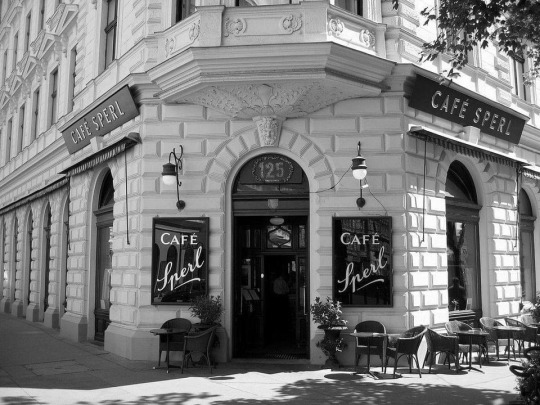
Das Café Sperl ...
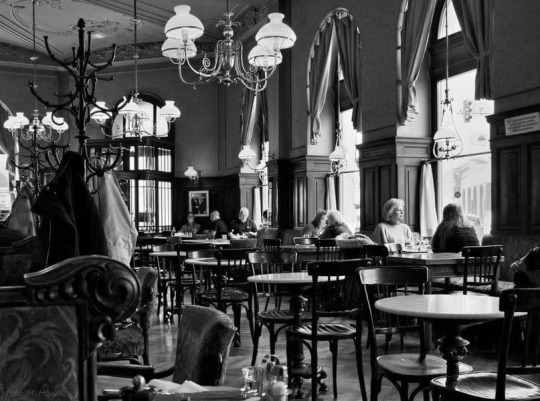
ist ein traditionsreiches, denkmalgeschütztes Wiener Kaffeehaus Ecke Gumpendorfer Straße und Lehargasse im 6. Wiener Gemeindebezirk Mariahilf.
1880 eröffnete Jacob Ronacher, Bruder von Anton Ronacher (dem Gründer des bekannten Etablissement Ronacher), ein Kaffeehaus unter dem Namen Café Ronacher im Eckgebäude Gumpendorfer Straße / Lehargasse. Die Ausgestaltung des Lokals im Stile eines Ringstraßen-Cafés mit Parkettboden, Stühlen von Thonet, Marmortischen, Kristallluster und Caramboltischen wurde von den Architekten Wilhelm Jelinek und Anton Groß ausgeführt. Noch im selben Jahr gab Ronacher jedoch das Geschäft auf und verkaufte es an die Familie Sperl, die es unter dem Namen Café Sperl weiterführte. 1884 wurde Adolf Kratochwilla Inhaber des Lokals, behielt aber den inzwischen etablierten Namen bei.
Zu den Stammgästen des Sperl zählten in der Zeit vor dem Ersten Weltkrieg eine kuriose Mischung aus Künstlern – Schriftstellern, Malern, Architekten, Komponisten, Musikern, Schauspielern – und Militärs der nahen k.u.k. Kriegsschule, zu letzteren zählten beispielsweise der spätere Chef des Generalstabs der österreichisch-ungarischen Armee Franz Conrad von Hötzendorf und Erzherzog Josef Ferdinand.
Von 1895 bis 1942 unterhielt der Künstlerbund Hagengesellschaft (aus dem 1900 der Hagenbund hervorgeht) hier seinen Stammtisch. Ebenfalls 1895 fand sich im Sperl der Siebenerclub, dem Josef Hoffmann, Leo Kleinradl, Adolf Karpellus, Maximilian Kurzweil, Koloman Moser, Joseph Maria Olbrich und Friedrich Pilz angehören, die später zusammen mit weiteren Künstlern die Wiener Secession ins Leben riefen. Darüber hinaus zählten in jener Zeit Joseph Lewinsky, Alexander Girardi, Edmund Eysler, Richard Heuberger, Karl Millöcker und Franz Lehár zu den Stammgästen des Sperl.
Nach dem Zweiten Weltkrieg nahm das Café seinen Betrieb wieder auf. 1968 übernahm Manfred Staub das Lokal von der Familie Kratochwilla und ließ es 1983 unter Erhaltung des denkmalgeschützten Ensembles renovieren. In den Folgejahren erlangte das Sperl verschiedene Auszeichnungen, so wurde es 1998 zum Österreichischen Kaffeehaus des Jahres ernannt und erhielt 2004 die Goldene Kaffeebohne. Zu den Stammgästen der jüngeren Vergangenheit zählten die Schriftsteller Jörg Mauthe, Robert Menasse und Michael Köhlmeier.
0 notes
Text

Zedlitzhalle, Ausstellungshaus des Hagenbundes
1908
2 notes
·
View notes
Photo

Just Pinned to Arts/Decos: Bronze and shell lamp by Gurschner influenced by Art Nouveau, Movement-Vienna Secession, Hagenbund http://ift.tt/2ykpTTW
0 notes
